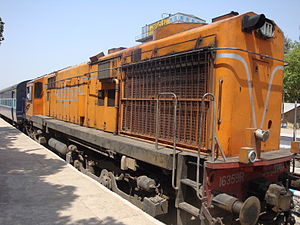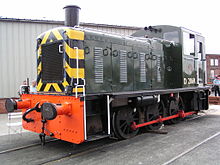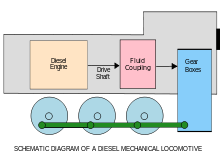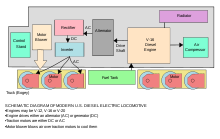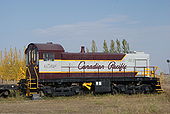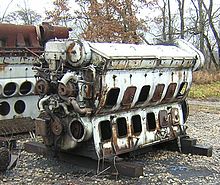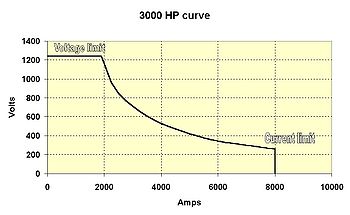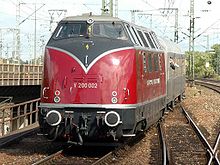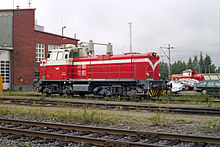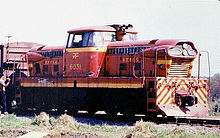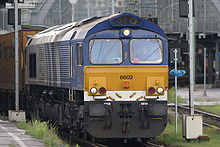- Diesel locomotive
-
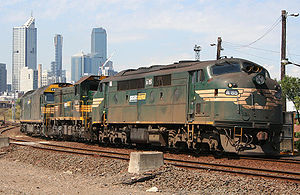 Three styles of diesel locomotive body: cab unit, hood unit and box cab. These locomotives are operated by Pacific National in Australia.
Three styles of diesel locomotive body: cab unit, hood unit and box cab. These locomotives are operated by Pacific National in Australia.
 The InterCity 125, the current confirmed record holder as the fastest diesel-powered train at 148 mph (238 km/h); is made up of two power cars, one at each end of a fixed formation of carriages; capable of 125 mph (201 km/h) in regular service.
The InterCity 125, the current confirmed record holder as the fastest diesel-powered train at 148 mph (238 km/h); is made up of two power cars, one at each end of a fixed formation of carriages; capable of 125 mph (201 km/h) in regular service.
A diesel locomotive is a type of railroad locomotive in which the prime mover is a diesel engine, a reciprocating engine operating on the Diesel cycle as invented by Dr. Rudolf Diesel. Several types of diesel locomotive have been developed, the principal distinction being in the means by which the prime mover's mechanical power is conveyed to the driving wheels (drivers).
Contents
Overview
Early internal combustion engine-powered locomotives used gasoline as their fuel. Soon after Dr. Rudolf Diesel patented his first compression ignition engine in 1892,[1] its application for railway propulsion was considered. Progress was slow, however, because of the poor power-to-weight ratio of the early engines, as well as the difficulty inherent in mechanically applying power to multiple driving wheels on swiveling trucks (bogies).
Steady improvements in the diesel engine's design (many developed by Sulzer Ltd. of Switzerland, with whom Dr. Diesel was associated for a time) gradually reduced its physical size and improved its power-to-weight ratio to a point where one could be mounted in a locomotive. Once the concept of Diesel-electric drive was accepted the pace of development quickened, and by 1925 a small number of diesel locomotives of 600 horsepower were in service in the United States. In 1930, Armstrong Whitworth of the United Kingdom delivered two 1,200 hp locomotives, using engines to Sulzer design, to Buenos Aires Great Southern Railway, of Argentina.
By the mid 1950s, with economic recovery from the Second World War, series production of diesel locomotives had begun in many countries and the diesel locomotive was on its way to become the dominant type of locomotive in many countries and regions, offering greater flexibility and performance than the steam locomotive, as well as substantially lower operating and maintenance costs, other than where electric traction was in use due to policy decisions. Currently, almost all diesel locomotives are diesel-electric, although the diesel-hydraulic type was also widely used between the 1950s and 1970s.
History
Adaptation of the diesel engine for rail use
The world's first oil-engined railway locomotive was built for the Royal Arsenal, Woolwich, England, in 1896, using an engine designed by Herbert Akroyd Stuart.[2] It was not, strictly, a diesel because it used a hot bulb engine (also known as a semi-diesel) but it was the precursor of the diesel.
Following the expiration of Dr. Rudolph Diesel’s patent in 1912, his engine design was successfully applied to marine propulsion and stationary applications. However, the massiveness and poor power-to-weight ratio of these early engines made them unsuitable for propelling land-based vehicles. Therefore, the engine's potential as a railroad prime mover was not initially recognized.[3] This changed as development reduced the size and weight of the engine.
The world’s first diesel-powered locomotive was operated in the summer of 1912 on the Winterthur-Romanshorn Railroad in Switzerland, but was not a commercial success.[4] In 1906, Rudolf Diesel, Adolf Klose and the steam and Diesel engine manufacturer Gebrüder Sulzer founded Diesel-Sulzer-Klose GmbH for the manufacture of Diesel-powered locomotives. Sulzer had been manufacturing Diesel engines since 1898. Prussian State Railways ordered in 1909 a Diesel locomotive from the company, and after test runs between Winterthur and Romanshorn the Diesel-mechanical locomotive was delivered in Berlin in September 1912. During further test runs in 1913 several problems were found. After the first world war broke out in 1914, all further trials were stopped. The locomotive weight was 95 tonnes and the power was 883 kW with a maximum speed of 100 km/h.[5] Small numbers of prototype diesel locomotives were produced in a number of countries through the mid 1920s.
Early American developments
Adolphus Busch purchased the American manufacturing rights for the Diesel engine in 1898 but never applied this new form of power to transportation. Only limited success was achieved in the early twentieth century with direct-driven gasoline and Diesel powered railcars.[6]
General Electric (GE) entered the railcar market in the early twentieth century, as Thomas Edison possessed an outstanding patent on the electric locomotive, his design actually being a type of electrically propelled railcar.[7] GE built its first electric locomotive prototype in 1895. However, high electrification costs caused GE to turn its attention to Diesel power to provide electricity for electric railcars. Problems related to co-coordinating the Diesel engine and electric motor were immediately encountered, primarily due to limitations of the Ward Leonard electric elevator drive system that had been chosen.
A significant breakthrough occurred in 1914, when Hermann Lemp, a GE electrical engineer, developed and patented a reliable direct current electrical control system (subsequent improvements were also patented by Lemp).[8] Lemp's design used a single lever to control both engine and generator in a coordinated fashion, and was the prototype for all diesel-electric locomotive control systems.
In 1917–18, GE produced three experimental diesel-electric locomotives using Lemp's control design, the first known to be built in the United States.[9] Following this development, the 1923 Kaufman Act banned steam locomotives from New York City because of severe pollution problems. The response to this law was to electrify high-traffic rail lines. However, electrification was uneconomical to apply to lower-traffic areas.
The first regular use of diesel-electric locomotives was in switching (shunter) applications. General Electric produced several small switching locomotives in the 1930s (the famous "44-tonner" switcher was introduced in 1940) Westinghouse Electric and Baldwin collaborated to build switching locomotives starting in 1929. However, the Great Depression curtailed demand for Westinghouse’s electrical equipment, and they stopped building locomotives internally, opting to supply electrical parts instead.[10]
First American series production locomotives
General Electric continued to be interested in developing a practical diesel railway locomotive, and approached Ingersoll-Rand in 1924. The resulting 300 horsepower locomotive was fitted with an electrical generator and traction motors supplied by GE, as well as a form of Lemp's control system, and was delivered in July 1925. This locomotive demonstrated that the diesel-electric power unit could provide many of the benefits of an electric locomotive without the railroad having to bear the sizeable expense of electrification.[11] The unit successfully demonstrated—in switching, road freight and passenger service—on a baker’s dozen of railroads, and became the prototype for 33 600 horsepower AGEIR boxcab switching locomotives built by a consortium of GE, I-R and the American Locomotive Company for several New York City railroads.[12]
In June 1925, Baldwin Locomotive Works outshopped a prototype diesel-electric locomotive for "special uses" (such as for runs where water for steam locomotives was scarce) using electrical equipment from Westinghouse Electric Company.[13] Its twin-engine design was not successful, and the unit was scrapped after a short testing and demonstration period.[14] Industry sources were beginning to suggest “the outstanding advantages of this new form of motive power.”[15] In 1929, the Canadian National Railways became the first North American railway to use diesels in mainline service with two units, 9000 and 9001, from Westinghouse.[16]
Diesel-electric railroad locomotion entered the American mainstream when the Burlington Railroad and Union Pacific used Diesel "streamliners" to haul passengers.[6][17] Following the successful 1939 tour of General Motors' EMD's FT demonstrator freight locomotive set, the transition from steam to Diesel power began, the pace substantially quickening in the years following the close of World War II. Fairbanks-Morse developed a unique opposed-piston engine that was used in their locomotives, as well as in submarines.[18]
Early diesel-electric locomotives in the United States used direct current (DC) traction motors, but alternating current (AC) motors came into widespread use in the 1990s, starting with the Electromotive SD70MAC in 1993 and followed by the General Electric's AC4400CW in 1994 and AC6000CW in 1995.[19]
Early diesel locomotives and railcars outside the United States
In 1935, Krauss-Maffei, MAN and Voith built the first diesel-hydraulic locomotive, the V140 in Germany. Because the German railways (DR) was very pleased with the performance of the locomotive, diesel-hydraulics became the mainstream in diesel locomotives in Germany. Series production of diesel locomotives in Germany began after the Second World War.
Diesel-powered or "oil-engined" railcars, generally diesel-mechanical, were developed by various European manufacturers in the 1930s, e.g. by William Beardmore and Company for the Canadian National Railways (the Beardmore Tornado engine was subsequently used in the R101 airship), the Flying Hamburger two coach diesel railcar which entered service in Germany in 1933, and the Vulcan railcars of 1940 for New Zealand.
In 1945 a batch of 30 Baldwin diesel-electric locomotives, Baldwin 0-6-6-0 1000, was delivered from the United States to the railways of the Soviet Union, although a first Russian diesel-electric locomotive (designed by a team led by Yuri Lomonosov) is reported to have entered service in 1924.
Fiat claims a first Italian diesel-electric locomotive built in 1922, but little detail is available. A Fiat-TIBB diesel-locomotive "A", of 440CV, is reported to have entered service on the Ferrovie Calabro Lucane in southern Italy in 1926, following trials in 1924-5. http://www.ferrovie.it/forum/viewtopic.php?f=22&t=13653 Series production of diesel locomotives in Italy began in the mid 1950s.
In 1948, the London Midland & Scottish Railway introduced the first of a pair of 1,600 hp Co-Co diesel-electric locomotives (later British Rail Class D16/1) for regular use in the United Kingdom, although British manufacturers such as Armstrong Whitworth had been exporting diesel locomotives since 1930. Fleet deliveries to British Railways, of other designs such as Class 20 and Class 31, began in 1957.
Series production of China's first diesel locomotive class, the DFH 1, began in 1964 following construction of a prototype in 1959.
Diesel’s advantages over steam
Diesel engines slowly eclipsed those powered by steam as the manufacturing and operational efficiencies of the former made them cheaper to own and operate. While initial costs of diesel engines were high, steam locomotives were custom-made for specific railway routes and lines and, as such, economies of scale were difficult to achieve.[20] Though more complex to produce with exacting manufacturing tolerances (1⁄10000-inch (0.0025 mm) for diesel, compared with 1⁄100-inch (0.25 mm) for steam), diesel locomotive parts were more conducive to mass production. While the steam engine manufacturer Baldwin offered almost five hundred steam models in its heyday, EMD offered fewer than ten diesel varieties.[21]
Diesel locomotives offer significant operating advantages over steam locomotives.[22] They can safely be operated by one person, making them ideal for switching/shunting duties in yards (although for safety reasons many main-line diesel locomotives continue to have 2-man crews) and the operating environment is much more attractive, being much quieter, fully weatherproof and without the dirt and heat that is an inevitable part of operating a steam locomotive.
Diesel engines can be started and stopped almost instantly, meaning that a diesel locomotive has the potential to incur no costs when not being used. However, it is still the practice of large North American railroads to use straight water as a coolant in diesel engines instead of coolants that incorporate anti-freezing properties; this results in diesel locomotives being left idling when parked in cold climates instead of being completely shut down. Still, a diesel engine can be left idling unattended for hours or even days, especially since practically every diesel engine used in locomotives has systems that automatically shut the engine down if a problem such as a loss of oil pressure or coolant loss occur.
Steam locomotives, by comparison, require intensive maintenance, lubrication and cleaning before, during and after use. Preparing and firing a steam locomotive for use from cold can take many hours, although it may be kept in readiness between uses with a small fire to maintain a slight heat in the boiler, but this requires regular stoking and frequent attention to maintain the level of water in the boiler. This may be necessary to prevent the water in the boiler freezing in cold climates, so long as the water supply itself is not frozen.
Moreover, maintenance and operational costs of steam locomotives were much higher than diesel counterparts even though it would take diesel locomotives almost 50 years to reach the same power output that steam locomotives could achieve at their technological height.[citation needed] Annual maintenance costs for steam locomotives accounted for 25% of the initial purchase price. Spare parts were cast from wooden masters for specific locomotives. The sheer number of unique steam locomotives meant that there was no feasible way for spare-part inventories to be maintained.[23]
Steam engines also required large quantities of coal and water, which were expensive variable operating costs.[24] Further, the thermal efficiency of steam was considerably less than that of diesel engines. Diesel’s theoretical studies demonstrated potential thermal efficiencies for a compression ignition engine of 36% (compared with 6-10% for steam), and a 1897 one-cylinder prototype operated at a remarkable 26% efficiency.[25]
The Trans-Australian Railway built 1912 to 1917 by Commonwealth Railways (CR) passes through 2000 km of waterless (or salt watered) desert terrain unsuitable for steam locomotives. The original engineer Henry Deane envisaged diesel operation to overcome such problems.[26] Some have suggested that the CR worked with the South Australian Railways to trial diesel traction.[27] However, the technology was not developed enough to be reliable.
By the mid 1960s, diesel locomotives had effectively replaced steam engines where electric traction was not in use.[24]
Transmission types
Unlike steam engines, internal combustion engines require a transmission to power the wheels. The engine must be allowed to continue to run when the locomotive is stopped.
Diesel-mechanical
A diesel-mechanical locomotive uses a mechanical transmission in a fashion similar to that employed in most road vehicles. This type of transmission is generally limited to low-powered, low speed shunting (switching) locomotives, lightweight multiple units and self-propelled railcars.
The mechanical transmissions used for railroad propulsion are generally more complex and much more robust than road versions. There is usually a fluid coupling interposed between the engine and gearbox, and the gearbox is often of the epicyclic (planetary) type to permit shifting while under load. Various systems have been devised to minimise the break in transmission during gear changing, e.g. the S.S.S. (synchro-self-shifting) gearbox used by Hudswell Clarke.
Diesel-mechanical propulsion is limited by the difficulty of building a reasonably sized transmission capable of coping with the power and torque required to move a heavy train. A number of attempts to use Diesel-mechanical propulsion in high power applications have been made (e.g. the 1,500 kW (2000 horsepower) British Rail 10100 locomotive), although none have proved successful in the end.
Diesel-electric
- For locomotives powered by both external electricity and diesel fuel, see electro-diesel below. For locomotives powered by a combination of diesel or fuel cells and batteries or ultracapacitors, see hybrid locomotive.
In a Diesel-electric locomotive, the Diesel engine drives an electrical generator whose output provides power to the traction motors. There is no mechanical connection between the engine and the wheels. The important components of Diesel-electric propulsion are the Diesel engine (also known as the prime mover), the main generator, traction motors and a control system consisting of the engine governor as well as electrical and/or electronic components used to control or modify the electrical supply to the traction motors, including switchgear, rectifiers and other components. In the most elementary case, the generator may be directly connected to the motors with only very simple switchgear.
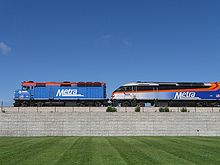 the EMD F40PH (left) and MPI MPXpress-series MP36PH-3S (right) locomotives coupled together by Metra use Diesel-electric transmission.
the EMD F40PH (left) and MPI MPXpress-series MP36PH-3S (right) locomotives coupled together by Metra use Diesel-electric transmission.
Originally, the traction motors and generator were DC machines. Following the development of high-capacity silicon rectifiers in the 1960s, the DC generator was replaced by an alternator using a diode bridge to convert its output to DC. This advance greatly improved locomotive reliability and decreased generator maintenance costs by elimination of the commutator and brushes in the generator. Elimination of the brushes and commutator, in turn, disposed of the possibility of a particularly destructive type of event referred to as a flashover, which could result in immediate generator failure and, in some cases, start an engine room fire.
More recently[when?], the development of high-power variable-frequency/variable-voltage (VVVF) drives, or "traction inverters," has allowed the use of polyphase AC traction motors, thus also eliminating the motor commutator and brushes. The result is a more efficient and reliable drive that requires relatively little maintenance and is better able to cope with overload conditions that often destroyed the older types of motors.
Diesel-electric control
A Diesel-electric locomotive's power output is independent of road speed, as long as the unit’s generator current and voltage limits are not exceeded. Therefore, the unit's ability to develop tractive effort (also referred to as drawbar pull or tractive force, which is what actually propels the train) will tend to inversely vary with speed within these limits. (See power curve below). Maintaining acceptable operating parameters was one of the principal design considerations that had to be solved in early Diesel-electric locomotive development and, ultimately, led to the complex control systems in place on modern units.
Throttle operation
The prime mover's power output is primarily determined by its rotational speed (RPM) and fuel rate, which are regulated by a governor or similar mechanism. The governor is designed to react to both the throttle setting, as determined by the engine driver and the speed at which the prime mover is running.[28]
Locomotive power output, and thus speed, is typically controlled by the engine driver using a stepped or "notched" throttle that produces binary-like electrical signals corresponding to throttle position. This basic design lends itself well to multiple unit (MU) operation by producing discrete conditions that assure that all units in a consist respond in the same way to throttle position. Binary encoding also helps to minimize the number of trainlines (electrical connections) that are required to pass signals from unit to unit. For example, only four trainlines are required to encode all throttle positions.
North American locomotives, such as those built by EMD or General Electric, have nine throttle positions, one idle and eight power (as well as an emergency stop position that shuts down the prime mover). Many UK-built locomotives have a ten-position throttle. The power positions are often referred to by locomotive crews as "run 3" or "notch 7", depending upon the throttle setting.
In older locomotives, the throttle mechanism was ratcheted so that it was not possible to advance more than one power position at a time. The engine driver could not, for example, pull the throttle from notch 2 to notch 4 without stopping at notch 3. This feature was intended to prevent rough train handling due to abrupt power increases caused by rapid throttle motion ("throttle stripping," an operating rules violation on many railroads). Modern locomotives no longer have this restriction, as their control systems are able to smoothly modulate power and avoid sudden changes in train loading regardless of how the engine driver operates the controls.
When the throttle is in the idle position, the prime mover will be receiving minimal fuel, causing it to idle at low RPM. In addition, the traction motors will not be connected to the main generator and the generator's field windings will not be excited (energized) — the generator will not produce electricity with no excitation. Therefore, the locomotive will be in "neutral". Conceptually, this is the same as placing an automobile's transmission into neutral while the engine is running.
To set the locomotive in motion, the reverser control handle is placed into the correct position (forward or reverse), the brake is released and the throttle is moved to the run 1 position (the first power notch). An experienced engine driver can accomplish these steps in a coordinated fashion that will result in a nearly imperceptible start. The positioning of the reverser and movement of the throttle together is conceptually like shifting an automobile's automatic transmission into gear while the engine is idling
Placing the throttle into the first power position will cause the traction motors to be connected to the main generator and the latter's field coils to be excited. With excitation applied, the main generator will deliver electricity to the traction motors, resulting in motion. If the locomotive is running "light" (that is, not coupled to a train) and is not on an ascending grade, it will easily accelerate. On the other hand, if a long train is being started, the locomotive may stall as soon as some of the slack has been taken up, as the drag imposed by the train will exceed the tractive force being developed. An experienced engine driver will be able to recognize an incipient stall and will gradually advance the throttle as required to maintain the pace of acceleration.
As the throttle is moved to higher power notches, the fuel rate to the prime mover will increase, resulting in a corresponding increase in RPM and horsepower output. At the same time, main generator field excitation will be proportionally increased to absorb the higher power. This will translate into increased electrical output to the traction motors, with a corresponding increase in tractive force. Eventually, depending on the requirements of the train's schedule, the engine driver will have moved the throttle to the position of maximum power and will maintain it there until the train has accelerated to the desired speed.
As will be seen in the following discussion, the propulsion system is designed to produce maximum traction motor torque at start-up, which explains why modern locomotives are capable of starting trains weighing in excess of 15,000 tons, even on ascending grades. Current technology allows a locomotive to develop as much as 30 percent of its loaded driver weight in tractive force, amounting to some 120,000 pounds of drawbar pull for a large, six-axle freight (goods) unit. In fact, a consist of such units can produce more than enough drawbar pull at start-up to damage or derail cars (if on a curve) or break couplers (the latter being referred to in North American railroad slang as "jerking a lung"). Therefore, it is incumbent upon the engine driver to carefully monitor the amount of power being applied at start-up to avoid damage. In particular, "jerking a lung" could be a calamitous matter if it were to occur on an ascending grade.
Propulsion system operation
As previously explained, the locomotive's control system is designed so that the main generator electrical power output is matched to any given engine speed. Given the innate characteristics of traction motors, as well as the way in which the motors are connected to the main generator, the generator will produce high current and low voltage at low locomotive speeds, gradually changing to low current and high voltage as the locomotive accelerates. Therefore, the net power produced by the locomotive will remain constant for any given throttle setting (see power curve graph for notch 8).
In older designs, the prime mover's governor and a companion device, the load regulator, play a central role in the control system. The governor has two external inputs: requested engine speed, determined by the engine driver's throttle setting, and actual engine speed (feedback). The governor has two external control outputs: fuel injector setting, which determines the engine fuel rate, and load regulator position, which affects main generator excitation. The governor also incorporates a separate overspeed protective mechanism that will immediately cut off the fuel supply to the injectors and sound an alarm in the cab in the event the prime mover exceeds a defined RPM. Not all of these inputs and outputs are necessarily electrical.
The load regulator is essentially a large potentiometer that controls the main generator power output by varying its field excitation and hence the degree of loading applied to the engine. The load regulator's job is relatively complex, because although the prime mover's power output is proportional to RPM and fuel rate, the main generator's output is not (which characteristic was not correctly handled by the Ward Leonard elevator drive system that was initially tried in early locomotives).
As the load on the engine changes, its rotational speed will also change. This is detected by the governor through a change in the engine speed feedback signal. The net effect is to adjust both the fuel rate and the load regulator position so that engine RPM and torque (and thus power output) will remain constant for any given throttle setting, regardless of actual road speed.
In newer designs controlled by a “traction computer,” each engine speed step is allotted an appropriate power output, or “kW reference”, in software. The computer compares this value with actual main generator power output, or “kW feedback”, calculated from traction motor current and main generator voltage feedback values. The computer adjusts the feedback value to match the reference value by controlling the excitation of the main generator, as described above. The governor still has control of engine speed, but the load regulator no longer plays a central role in this type of control system. However, the load regulator is retained as a “back-up” in case of engine overload. Modern locomotives fitted with electronic fuel injection (EFI) may have no mechanical governor, however a “virtual” load regulator and governor are retained with computer modules.
Traction motor performance is controlled either by varying the DC voltage output of the main generator, for DC motors, or by varying the frequency and voltage output of the VVVF for AC motors. With DC motors, various connection combinations are utilized to adapt the drive to varying operating conditions.
At standstill, main generator output is initially low voltage/high current, often in excess of 1000 amperes per motor at full power. When the locomotive is at or near standstill, current flow will be limited only by the DC resistance of the motor windings and interconnecting circuitry, as well as the capacity of the main generator itself. Torque in a series-wound motor is approximately proportional to the square of the current. Hence, the traction motors will produce their highest torque, causing the locomotive to develop maximum tractive effort, enabling it to overcome the inertia of the train. This effect is analogous to what happens in an automobile automatic transmission at start-up, where it is in first gear and thus producing maximum torque multiplication.
As the locomotive accelerates, the now-rotating motor armatures will start to generate a counter-electromotive force (back EMF, meaning the motors are also trying to act as generators), which will oppose the output of the main generator and cause traction motor current to decrease. Main generator voltage will correspondingly increase in an attempt to maintain motor power, but will eventually reach a plateau. At this point, the locomotive will essentially cease to accelerate, unless on a downgrade. Since this plateau will usually be reached at a speed substantially less than the maximum that may be desired, something must be done to change the drive characteristics to allow continued acceleration. This change is referred to as "transition," a process that is analogous to shifting gears in an automobile.
Transition methods include:
- Series / Parallel or "motor transition".
- Initially, pairs of motors are connected in series across the main generator. At higher speed, motors are reconnected in parallel across the main generator.
- "Field shunting", "field diverting", or "weak fielding".
- Resistance is connected in parallel with the motor field. This has the effect of increasing the armature current, producing a corresponding increase in motor torque and speed.
Both methods may also be combined, to increase the operating speed range.
- Generator transition
- Reconnecting the two separate internal main generator stator windings from parallel to series to increase the output voltage.
In older locomotives, it was necessary for the engine driver to manually execute transition by use of a separate control. As an aid to performing transition at the right time, the load meter (an indicator that informs the engine driver on how much current is being drawn by the traction motors) was calibrated to indicate at which points forward or backward transition should take place. Automatic transition was subsequently developed to produce better operating efficiency, and to protect the main generator and traction motors from overloading from improper transition.
Dynamic braking
Main article: Dynamic brakeA common option on Diesel-electric locomotives is dynamic (rheostatic) braking.
Dynamic braking takes advantage of the fact that the traction motor armatures are always rotating when the locomotive is in motion and that a motor can be made to act as a generator by separately exciting the field winding. When dynamic braking is utilized, the traction control circuits are configured as follows:
- The field winding of each traction motor is connected across the main generator.
- The armature of each traction motor is connected across a forced-air cooled resistance grid (the dynamic braking grid) in the roof of the locomotive's hood.
- The prime mover RPM is increased and the main generator field is excited, causing a corresponding excitation of the traction motor fields.
The aggregate effect of the above is to cause each traction motor to generate electric power and dissipate it as heat in the dynamic braking grid. A fan connected across the grid provides forced-air cooling. Consequently, the fan is powered by the output of the traction motors and will tend to run faster and produce more airflow as more energy is applied to the grid.
Ultimately, the source of the energy dissipated in the dynamic braking grid is the motion of the locomotive as imparted to the traction motor armatures. Therefore, the traction motors impose drag and the locomotive acts as a brake. As speed decreases, the braking effect decays and usually becomes ineffective below approximately 16 km/h (10 mph), depending on the gear ratio between the traction motors and axles.
Dynamic braking is particularly beneficial when operating in mountainous regions, where there is always the danger of a runaway due to overheated friction brakes during descent (see also comments in the air brake article regarding loss of braking due to improper train handling). In such cases, dynamic brakes are usually applied in conjunction with the air brakes, the combined effect being referred to as blended braking. The use of blended braking can also assist in keeping the slack in a long train stretched as it crests a grade, helping to prevent a "run-in", an abrupt bunching of train slack that can cause a derailment. Blended braking is also commonly used with commuter trains to reduce wear and tear on the mechanical brakes that is a natural result of the numerous stops such trains typically make during a run.
Electro-diesel
These special locomotives can operate as an electric locomotive or as a Diesel locomotive. The Long Island Rail Road and Metro-North Railroad operate dual-mode diesel-electric/third-rail locomotives between non-electrified territory and New York City because of a local law banning diesel-powered locomotives in Manhattan tunnels. For the same reason, Amtrak operates a fleet of dual-mode locomotives in the New York area. British Rail operated dual diesel-electric/electric locomotives designed to run primarily as electric locomotives. This allowed railway yards to remain un-electrified, as the third rail power system is extremely hazardous in a yard area.
Diesel-hydraulic
Diesel-hydraulic locomotives use a torque converter or hydraulic drive system to convey the power from the diesel engine to the wheels.
Hydrokinetic transmission
Hydrokinetic transmission (also called hydrodynamic transmission) uses a torque converter. A torque converter consists of three main parts, two of which rotate, and one that has a lock preventing backwards rotation and adding output torque by redirecting the oil flow at low output RPM. All three main parts are sealed in an oil-filled housing. To match engine speed to load speed over the entire speed range of a locomotive some additional method is required to give sufficient range. One method is to follow the torque converter with a mechanical gearbox which switches ratios automatically, similar to an automatic transmission on a car. Another method is to provide several torque converters each with a range of variability covering part of the total required; all the torque converters are mechanically connected all the time, and the appropriate one for the speed range required is selected by filling it with oil and draining the others. The filling and draining is carried out with the transmission under load, and results in very smooth range changes with no break in the transmitted power.
Multiple units
Diesel-hydraulic multiple units, a less arduous duty, often use a simplification of this system, with a torque converter for the lower speed ranges and a fluid coupling for the high speed range.[citation needed] A fluid coupling is similar to a torque converter but it lacks the stator. The output torque is equal to the input torque regardless of the ratio of input to output speed; loading the output shaft results not in torque multiplication and constant power throughput but in reduction of the input speed with consequent lower power throughput. (In car terms, the fluid coupling provides top gear and the torque converter provides all the lower gears.) The result is that the power available at the rail is reduced when operating in the lower speed part of the fluid coupling range, but the less arduous duty of a passenger multiple unit compared to a locomotive makes this an acceptable trade-off for reduced mechanical complexity.[citation needed]
Locomotives
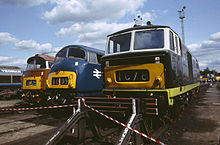 British Rail diesel-hydraulic locomotives: Class 52 "Western", Class 42 "Warship" and Class 35 "Hymek"
British Rail diesel-hydraulic locomotives: Class 52 "Western", Class 42 "Warship" and Class 35 "Hymek"
Diesel-hydraulic locomotives are less efficient than diesel-electrics. The first-generation BR diesel hydraulics were significantly less efficient (c. 65%) than diesel electrics (c. 80%)—but initial versions were found in many countries to be mechanically more complicated and more likely to break down. Hydraulic transmission for locomotives was developed in Germany. The bad reputation of diesel-hydraulic principle was caused by the poor durability and reliability of the Maybach Mekydro hydraulic transmission. The Mekydro consisted of a hydraulic torque converter followed by a four speed automatic mechanical gearbox. Voith developed a different solution using several torque converters, and it has proven to be extremely durable and very well-suited for the purpose.
Reliability
In Germany and Finland, diesel-hydraulic systems have achieved extremely high reliability in operation. Persistent argument continues over the relative reliability of hydraulic systems, with continuing questions over whether data were manipulated politically to favour local suppliers over German ones.[citation needed] In the US and Canada, they are now greatly outnumbered by diesel-electric locomotives, while they remain dominant in some European countries.
Examples
The most famous[citation needed] diesel-hydraulic locomotive is the German V 200, which were built from 1953 in a total number of 136. The only diesel-electric locomotives of the Deutsche Bundesbahn were BR 288 (V 188), of which the Deutsche Reichsbahn built 12 in 1939.
In the UK, the Western Region of British Rail bought a number of Diesel-hydraulic locomotives, ranging from small light-duty freight locomotives to high-powered mainline passenger locomotives, but these were withdrawn early because they were non-standard, and also in some cases suffering from reliability problems (see above), being replaced by diesel-electrics. A number were rescued for preservation though, and some are capable of running on the mainline.
In Finland, over 200 Finnish-built VR class Dv12 and Dr14 diesel-hydraulics with Voith transmissions have been continuously used since the early 1960s. All units of Dr14 class and most units of Dv12 class are still in service. VR has abandoned some weak-conditioned units of 2700 series Dv12s.[29]
In the 1950s, General Motors Diesel of Canada built 4 GMD GMDH-1 experimental locomotives.
In 1959 the South African Railways (SAR) placed seven Henschel built diesel-hydraulic locomotives in service. Designated as South African Class 61-000, all but one were later sold to Rhodesia Railways, where they became RR Class DH1.
In the 1960s, the Southern Pacific (SP) bought 18 diesel-hydraulic locomotives KM ML-4000 from the Kraus-Maffei company. The Denver & Rio Grande Western also bought three, all of which it later sold to SP.[30] Only the outer shell of one of these (converted into a camera car by SP in the 1970s) exists today, the other 20 having been scrapped when SP terminated the experiment in 1970.
Hydrostatic transmission
Hydrostatic transmission is limited to small shunting locomotives and rail maintenance equipment. The diesel engine drives a hydraulic pump which supplies oil under pressure to hydraulic motors which drive the axles.
Diesel-steam
Steam-diesel hybrid locomotives can use steam generated from a boiler or diesel to power a piston engine. The Cristiani Compressed Steam System used a diesel engine to power a compressor to drive and recirculate steam produced by a boiler; effectively using steam as the power transmission medium, with the diesel engine being the prime mover[31]
Diesel-pneumatic
The diesel-pneumatic locomotive was of interest in the 1930s because it offered the possibility of converting existing steam locomotives to diesel operation. The frame and cylinders of the steam locomotive would be retained and the boiler would be replaced by a diesel engine driving an air compressor. The problem was low thermal efficiency because of the large amount of energy wasted as heat in the air compressor. Attempts were made to compensate for this by using the diesel exhaust to re-heat the compressed air but these had limited success. A German proposal of 1929 did result in a prototype[32] but a similar British proposal of 1932, to use an LNER Class R1 locomotive, never got beyond the design stage.
Multiple-unit operation
Most Diesel locomotives are capable of multiple unit operation (MU) as a means of increasing horsepower and tractive effort when hauling heavy trains. All North American locomotives, including export models, use a standardised AAR electrical control system interconnected by a 27-pin jumper cable between the units. For UK-built locomotives, a number of incompatible control systems are used, but the most common is the Blue Star system, which is electro-pneumatic and fitted to most early diesel classes. A small number of types, typically higher-powered locomotives intended for passenger only work, do not have multiple control systems. In all cases, the electrical control connections made common to all units in a consist are referred to as trainlines. The result is that all locomotives in a consist behave as one in response to the engine driver's control movements.
The ability to MU Diesel-electric locomotives was first introduced in the EMD FT four-unit demonstrator that toured the USA in 1939. At the time, American railroad work rules required that each operating locomotive in a train had to have on board a full crew. EMD circumvented that requirement by joining the individual units of the demonstrator with drawbars instead of conventional knuckle couplers and declaring the combination to be a single locomotive. Electrical interconnections were made so one engine driver could operate the entire consist from the head-end unit. Later on, work rules were amended and the semi-permanent joining of units with drawbars was eliminated in favour of couplers, as servicing had proved to be somewhat cumbersome owing to the total length of the consist (about 200 feet or nearly 61 meters).
In mountainous regions, it is common to interpose helper locomotives in the middle of the train, both to provide the extra power needed to ascend a grade and to limit the amount of stress applied to the draft gear of the car coupled to the head-end power. The helper units in such distributed power configurations are controlled from the lead unit's cab through coded radio signals. Although this is technically not MUing, the behaviour is the same as with physically interconnected units.
Cab arrangements
Cab arrangements vary by builder and operator. Practice in the U.S. has traditionally been for a cab at one end of the locomotive with limited visibility if the locomotive is not operated cab forward. This is not usually a problem as U.S. locomotives are usually operated in pairs, or threes, and arranged so that a cab is at each end of each set. European practice is usually for a cab at each end of the locomotive as trains are usually light enough to operate with one locomotive. Early U.S. practice was to add power units without cabs (booster or B-units) and the arrangement was often A-B, A-B-A, or A-B-B-A where A was a unit with a cab. Center cabs were sometimes used for switch locomotives.
Cow-calf
In North American railroading, a cow-calf set is a pair of switcher-type locomotives: one (the cow) equipped with a driving cab, the other (the calf) without a cab, and controlled from the cow through cables. Cow-calf sets are used in heavy switching and hump yard service. Some are radio controlled without an operating engineer present in the cab. This arrangement is also known as master-slave.
Flameproof diesel locomotive
A standard diesel locomotive presents a very low fire risk but “flameproofing” can reduce the risk even further. This involves fitting a water-filled box to the exhaust pipe to quench any red-hot carbon particles that may be emitted. Other precautions may include a fully insulated electrical system (neither side earthed to the frame) and all electric wiring enclosed in conduit.
The flameproof diesel locomotive has replaced the fireless steam locomotive in areas of high fire risk such as oil refineries and ammunition dumps. Preserved examples of flameproof diesel locomotives include:
- Francis Baily of Thatcham (ex-RAF Welford) at Southall Railway Centre
- Naworth (ex-National Coal Board) at the South Tynedale Railway[33]
Latest development of the "Flameproof Diesel Vehicle Applied New Exhaust Gas Dry Type Treatment System " does not need the water supply.[34]
Lights
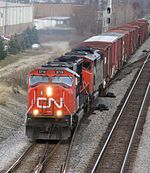 A Canadian National Railway train showing the placement of the headlight and ditch lights on the locomotive.
A Canadian National Railway train showing the placement of the headlight and ditch lights on the locomotive.
The lights fitted to diesel locomotives vary from country to country. North American locomotives have a powerful headlight and a pair of ditch lights. The latter are fitted low down at the front and are designed to make the locomotive easily visible as it approaches a grade crossing. Older locomotives may be fitted with a Gyralite or Mars Light instead of the ditch lights.
Environmental impact
Although diesel locomotives pollute considerably less than steam locomotives, they still emit diesel exhaust that contributes to health effects (especially cardiovascular) and global warming.[35] In 2008, the United States Environmental Protection Agency (EPA) mandated regulations requiring all new or refurbished diesel locomotives to meet pollution standards that slash the amount of allowable soot by 90% and require an 80% reduction in nitrogen oxide emissions. For years, it was thought by government scientists who measure air pollution that diesel locomotive engines were relatively clean and emitted far less health-threatening emissions than that of diesel trucks or other vehicles; however, the scientists discovered that because they used faulty estimates of the amount of fuel consumed by diesel locomotives, they grossly understated the amount of pollution generated annually. After revising their calculations, they concluded that the annual emissions of nitrogen oxide, a major ingredient in smog, and soot would be by 2030 nearly twice what they originally assumed.[36][37]
This would mean that diesel locomotives would be releasing more than 800,000 tons of nitrogen oxide and 25,000 tons of soot every year within a quarter of a century, in contrast to the EPA's previous projections of 480,000 tons of nitrogen dioxide and 12,000 tons of soot. Since this was discovered, to reduce the effects of the diesel locomotive on humans (who are breathing the noxious emissions) and on plants and animals, it is considered practical to install traps in the diesel engines to reduce pollution levels[38] and other forms (e.g., use of biodiesel).
Diesel locomotive pollution has been of particular concern in the city of Chicago. The Chicago Tribune reported levels of diesel soot inside locomotives leaving Chicago at levels hundreds of times above what is normally found on streets outside.[39] Residents of several neighborhoods are most likely exposed to diesel emissions at levels several times higher than the national average for urban areas.[40]
See also
- Diesel multiple unit
- Diesel-electric transmission
- Diesel engine
- Electric locomotive
- Electro-diesel locomotive
- Electrification
- Hybrid locomotive
- Hybrid electric vehicle
References
- ^ Diesel, Rudolf. U.S. Patent No. 608,845, filed July 15, 1895, and issued August 9, 1898 Accessed via Google Patent Search at: US Patent #608,845 on February 8, 2007.
- ^ Doherty, J M 1962: Diesel Locomotive Practice. Odhams Press
- ^ Churella, Albert J. (1998). From Steam to Diesel: Managerial Customs and Organizational Capabilities in the Twentieth-Century American Locomotive Industry. Princeton, New Jersey: Princeton University Press. p. 15. ISBN 0-691-02776-5.
- ^ Churella, page 12
- ^ Glatte, Wolfgang (1993). Deutsches Lok-Archiv: Diesellokomotiven 4. Auflage. Berlin: Transpress. ISBN 3-344-70767-1.
- ^ a b Stover, John F. (1997). American Railroads. Chicago, Illinois: The University of Chicago Press. p. 212. ISBN 0-226-77658-I.
- ^ Edison, Thomas A. U.S. Patent No. 493,425, filed January 19, 1891, and issued March 14, 1891 Accessed via the Edison Papers at: US Patent #493,425 on February 8, 2007.
- ^ Lemp, Hermann. U.S. Patent No. 1,154,785, filed April 8, 1914, and issued September 28, 1915. Accessed via Google Patent Search at: US Patent #1,154,785 on February 8, 2007.
- ^ Pinkepank, Jerry A. (1973). The Second Diesel Spotter’s Guide. Milwaukee WI: Kalmbach Books. pp. 139–141. ISBN 0-89024-026-4.
- ^ Churella, pp. 28-30.
- ^ Churella, pp. 25-27.
- ^ Pinkepank, p. 209–211.
- ^ "Railroads To Try Diesel Locomotive", Special to the New York Times: 1, February 18, 1925
- ^ Pinkepank, p. 283.
- ^ Churella, p. 27.
- ^ Pinkepank, p. 409.
- ^ "Diesel Streamliners Now Link Coast-to-Coast" Popular Mechanics, August 1937
- ^ Wendel, C.H. (1987). Power in the Past, Vol. 2; A History of Fairbanks-Morse and Co., Stemgas Publishing Company, 1982.
- ^ Solomon, Brian, Locomotive, 2001, pp 120, 130
- ^ Churella, 10
- ^ Churella, 19
- ^ http://www.sdrm.org/faqs/hostling.html, Phil Jern "How to Boot a Steam Locomotive" (1990) San Diego Railroad Museum.
- ^ Churella, 12-17
- ^ a b Stover, 213
- ^ Churella, 14
- ^ Burke, A 1991., Rails through the Wilderness; New South Wales University Press
- ^ Holden, R 2006 No. 259 : the curious story of a forgotten locomotive, Railmac Publications
- ^ Control theory
- ^ Suruliputus saatteli veturit viimeiselle matkalle (Finnish)
- ^ Marre, Louis A. (1995). Diesel Locomotives: The First Fifty Years. Waukesha, Wis., USA: Kalmbach. pp. 384–385. ISBN 0890242585.
- ^ The Paragon-Cristiani Compressed Steam System dslef.dsl.pipex.com
- ^ "A German Diesel-Pneumatic Locomotive". Douglas-self.com. http://www.douglas-self.com/MUSEUM/LOCOLOCO/diesair/diesair.htm. Retrieved 2011-08-20.
- ^ [1][dead link]
- ^ "Development of the Flameproof Diesel Vehicle Applied New Exhaust Gas Dry Type Treatment System". Sciencelinks.jp. 2009-03-18. http://sciencelinks.jp/j-east/article/200210/000020021002A0274001.php/. Retrieved 2011-08-20.
- ^ King, Joe (2008-09-22). "Engineering gets $1 million grant to make locomotives leaner, greener". Northern Illinois University. http://www.niu.edu/northerntoday/2008/sept22/locomotive.shtml. Retrieved 2011-08-06.
- ^ Eilperin, Juliet (2006-08-14). "Attention to Locomotives' Emissions Renewed". Washington Post. http://www.washingtonpost.com/wp-dyn/content/article/2006/08/13/AR2006081300530.html. Retrieved 2011-08-06.
- ^ Hawthorne, Michael (February 14, 2011). "Metra finds 'alarming' pollution on some trains". Chicago Tribune. http://articles.chicagotribune.com/2011-02-14/news/ct-met-metra-air-testing-20110213_1_scott-fruin-outbound-trains-oldest-trains. Retrieved 2011-08-06.
- ^ Wilkins, Davell (2011-04-13). "Study: Installed Traps In Diesel Engines Reduce Pollution Levels". Top News. http://topnews.us/content/238438-study-installed-traps-diesel-engines-reduce-pollution-levels. Retrieved 2011-08-06.
- ^ "Pollution on Metra Trains Worse Than Thought: Report". Fox Chicago News. 2011-02-14. http://www.myfoxchicago.com/dpp/news/metro/metra-train-cars-pollution-soot-worse-report-20110214. Retrieved 2011-08-06.
- ^ Lydersen, Kari (April 21, 2011). "Black Carbon Testing Finds High Levels". The New York Times. http://www.nytimes.com/2011/04/22/us/22cnccarbon.html. Retrieved August 6, 2011.
External links
Categories:- Diesel locomotives
- Diesel-electric vehicles
- Rail transport
Wikimedia Foundation. 2010.


